Menu
No products in the Quote Basket.
9 am to 6 pm PST time
No products in the Quote Basket.
SMART CUT Braised Bond diamond band saw blades are crafted through a metallurgical bonding process that securely attaches diamonds to high-grade steel edges. This innovative technique ensures our blades are not only reliable and long-lasting but also resistant to brittleness, setting them apart as a superior choice compared to both traditional toothed and electroplated diamond saw blades.
Engineered with meticulous precision and uncompromising quality standards, SMART CUT diamond band saw blades are ideal for applications requiring exceptional precision and tight control. Trust in our blades for superior performance and durability.
SMART CUT Braised Bond Diamond Band Saw is a significant improvement on traditional toothed or electroplated diamond alternatives and an added value performance upgrade to the successful NT Tools Tungsten Carbide range of blades.
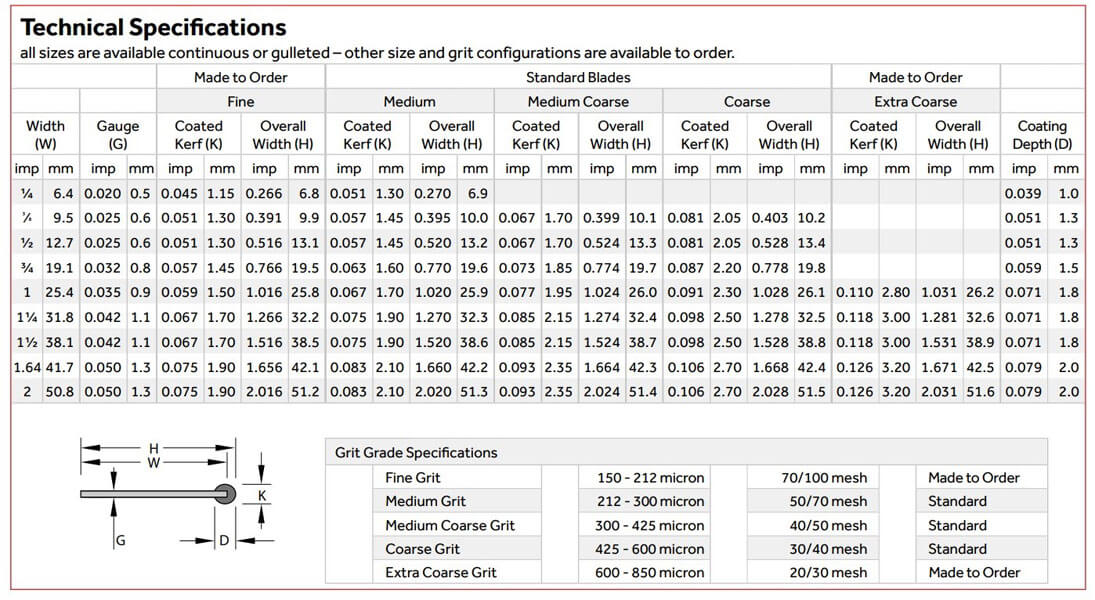
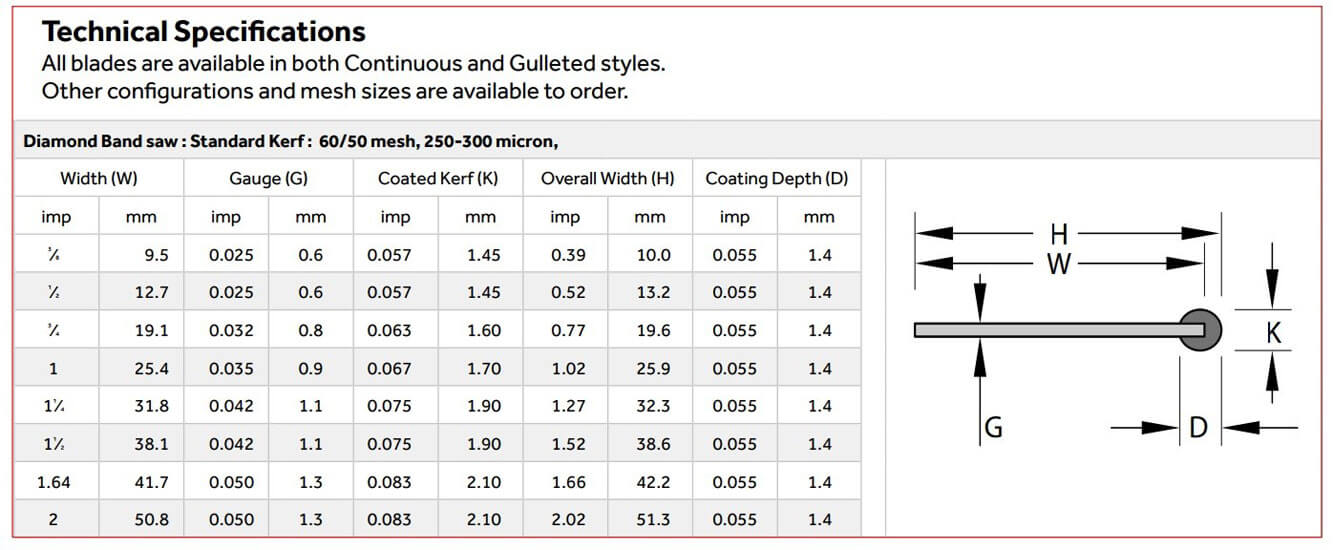
Tab Content
Tab Content
Tab Content
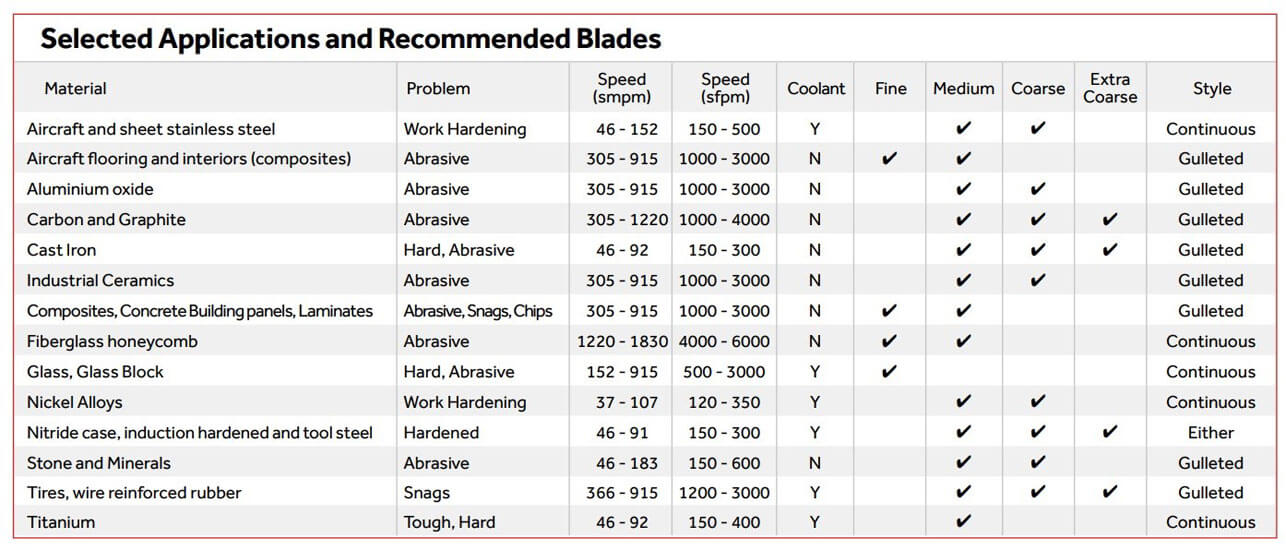
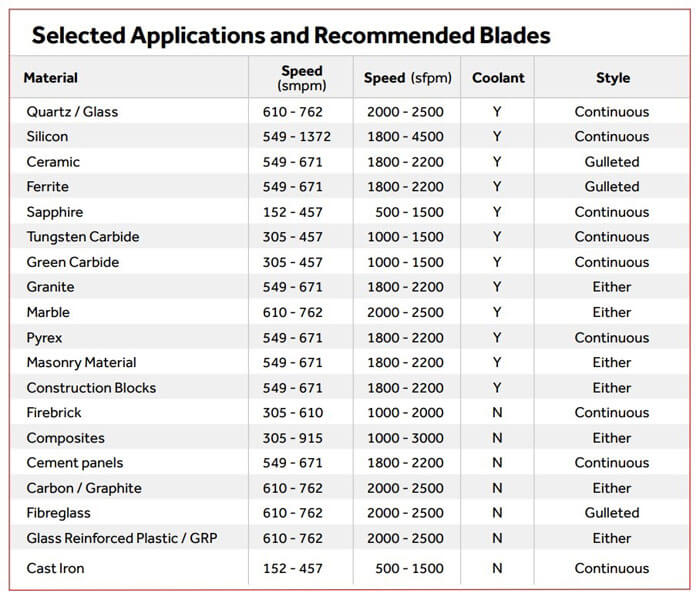
The recommended RPM (Revolutions Per Minute) for diamond band saw blades can vary significantly based on several factors including the type of material being cut, the diameter of the blade, the hardness of the material, and the specific design of the blade. Here are some general guidelines to consider:
Problem
Possible Causes
Solutions
Blade Breakage
Excessive tension
Reduce blade tension
Improper blade size for machine
Ensure correct blade size is used
Excessive feed pressure
Adjust feed pressure to recommended level
Fatigue from repeated bending
Check and adjust blade tracking
Blade Dulling Quickly
Incorrect blade speed
Adjust to optimal speed for material
Inadequate coolant or wrong type
Check coolant flow and type; replace if necessary
Cutting material too hard for blade
Use a blade suitable for the material hardness
Overuse without rest
Allow intervals of rest for the blade
Inaccurate Cuts
Worn or damaged blade guides
Inspect and replace blade guides as needed
Blade misalignment
Align the blade correctly
Incorrect blade tension
Adjust blade tension to recommended level
Using a blade with incorrect tooth pitch
Use a blade with appropriate tooth pitch
Excessive Vibration
Worn bearings
Inspect and replace bearings if needed
Misaligned wheels
Align the saw wheels properly
Damaged blade
Replace the blade
Loose components in the machine
Tighten all loose parts and components
Difficulty in Starting the Cut
Dull blade
Replace or sharpen the blade
Incorrect blade for material type
Select the appropriate blade for the material
Insufficient coolant
Ensure adequate coolant flow
Improper technique
Review and adjust cutting technique
Excessive Noise
Blade hitting machine parts
Check and adjust blade tracking
Loose components
Tighten all loose parts and components
Worn or damaged blade
Inspect blade for damage and replace if necessary
Uneven Wear on Blade
Improper blade tension
Adjust blade tension to even out wear
Misaligned blade
Realign the blade
Uneven material surface
Ensure material is uniformly supported
Uneven Cut Surface
Worn or damaged blade teeth
Replace or sharpen the blade
Blade running at incorrect speed
Adjust blade speed according to material specifications
Improper blade tension
Adjust tension to recommended levels
Excessive Blade Wear
Continuous operation without breaks
Allow the blade to rest periodically
Cutting abrasive materials
Use blades designed for abrasive materials
Insufficient or inappropriate coolant
Use the correct coolant and ensure proper flow
Saw Not Cutting Straight
Blade guides misaligned
Realign the blade guides
Worn or damaged blade
Replace the blade
Machine components out of calibration
Calibrate machine components
Frequent Blade Slippage
Insufficient blade tension
Increase blade tension to proper level
Worn or damaged drive wheels
Replace or repair the drive wheels
Coolant on the blade or wheels
Clean the blade and wheels, ensure coolant is controlled
Coolant Issues
Clogged coolant nozzles
Clean or replace the nozzles
Insufficient coolant flow
Adjust the coolant system for better flow
Incorrect coolant mixture
Ensure the correct mixture and type of coolant
Increased Power Consumption
Blade binding in the cut
Check for proper blade alignment and tension
Dull blade increasing resistance
Replace or sharpen the blade
Motor or drive system issues
Inspect and service the motor and drive system
Difficulty in Blade Installation
Incorrect blade length or width
Use the correct size of blade for your saw
Tension mechanism issues
Inspect and repair the tension mechanism
Misalignment of blade path components
Align the components properly
Blade Deviates from Cut Line
Incorrect blade tension
Adjust tension to recommended levels
Worn or damaged blade teeth
Replace the blade
Misaligned blade guides
Adjust or replace blade guides
Rapid Tooth Strip Off
Excessively hard material
Use a blade designed for harder materials
Too high feed rate
Reduce feed rate
Insufficient blade tension
Adjust blade tension
Blade Binding
Misaligned workpiece
Ensure proper workpiece alignment
Inadequate support for workpiece
Use appropriate supports to stabilize workpiece
Blade worn or damaged
Replace the blade
Irregular Tooth Wear
Uneven material hardness
Check material consistency
Incorrect blade for material type
Select the appropriate blade for the material
Improper blade tension
Adjust tension to recommended levels
Slow Cutting Speed
Blade becoming dull
Replace or sharpen the blade
Incorrect blade speed for material
Adjust the blade speed according to material type
Inadequate power supply to saw
Check and ensure proper power supply
Noise or Chatter During Cutting
Loose components in the saw
Tighten all loose parts and components
Blade tension too low
Increase blade tension
Worn or damaged blade guides
Replace or adjust blade guides
Difficulty in Controlling Cut Direction
Blade too wide for the curve being cut
Use a narrower blade for tight curves
Inadequate blade tension
Adjust tension to recommended levels
Worn or damaged blade
Replace the blade
Excessive Coolant Spatter
High coolant pressure
Adjust the coolant pressure to a lower setting
Misaligned coolant nozzles
Adjust the nozzle alignment
Excessive blade speed
Reduce blade speed
Motor Overheating
Overloading the saw
Reduce feed rate and check for correct blade usage
Inadequate ventilation
Ensure proper ventilation around the motor
Electrical issues
Check and fix any electrical connections and components
Problem
Possible Causes
Solutions
Reduced Cutting Precision
Blade wear and tear
Replace the blade with a new one
Incorrect blade type for the task
Use a blade type more suited to the material
Machine calibration issues
Calibrate the saw according to manufacturer’s guide
Frequent Overheating of Blade or Saw
Continuous operation without adequate cooling
Ensure regular cooling intervals; check coolant system
Overfeeding the material
Reduce feed rate to decrease strain on the blade
Inefficient coolant system
Check and repair the coolant system
Increased Material Waste
Blade wandering off course
Check blade alignment and tension
Incorrect blade width for the material
Use a blade width appropriate for the material
Improper feed rate
Adjust the feed rate for more efficient cutting
Blade Becomes Stuck in Material
Insufficient blade tension
Increase blade tension
Debris build-up on the blade
Clean the blade regularly
Worn or damaged blade teeth
Replace the blade
Difficulty in Blade Tracking
Misalignment of wheels or guides
Adjust the alignment of wheels and guides
Worn or damaged tires on wheels
Replace tires on wheels
Blade not properly seated
Reinstall the blade correctly
Inconsistent Blade Life
Variation in material hardness
Use a blade suited for varying material hardness
Fluctuating feed rates
Stabilize feed rate
Inconsistent maintenance practices
Establish a regular maintenance routine
Excessive Noise During Start-up
Loose components or covers
Tighten all loose components and covers
Motor or belt issues
Inspect and repair/replace motor or belts
Dry or unlubricated moving parts
Lubricate moving parts according to guide
Difficulty in Adjusting Blade Tension
Faulty tension adjustment mechanism
Repair or replace the tension adjustment mechanism
Worn tension springs
Replace tension springs
Corrosion or debris in tensioning components
Clean and lubricate tensioning components
Problem
Possible Causes
Solutions
Frequent Resetting of Circuit Breaker
Electrical overload
Check electrical load and reduce if necessary
Short circuit in saw wiring
Inspect and repair any wiring issues
Faulty motor
Inspect and replace the motor if necessary
Blade Falling Off the Wheels
Insufficient blade tension
Adjust the blade tension
Worn or improperly aligned wheel tires
Replace or realign the wheel tires
Damaged or misaligned blade wheels
Repair or replace the blade wheels
Inefficient Cutting of Curves
Blade too wide for tight curves
Use a narrower blade for tighter curves
Incorrect blade tension
Adjust the blade tension
Improper saw speed
Adjust the saw speed to match the cutting requirement
Vibration in the Saw
Unbalanced wheels
Balance the wheels
Loose components in the saw
Tighten all loose parts and components
Worn bearings or drive belts
Replace worn bearings or drive belts
Difficulty in Maintaining Cut Line
Blunt blade teeth
Sharpen or replace the blade
Incorrect blade for the type of material
Use a blade that is suitable for the material
Misalignment of blade guides
Adjust or replace the blade guides
Excessive Dust and Debris Accumulation
Inadequate dust extraction system
Improve or install a proper dust extraction system
Blade not clearing debris
Check blade type and condition
effectively
replace if necessary
Overloading the saw with material
Reduce the volume of material processed at a time
Difficulty in Blade Alignment
Misaligned blade tracking
Adjust the blade tracking
Worn out blade tensioning components
Replace or repair tensioning components
Debris on blade path
Clean the blade path thoroughly
Blade Chipping or Cracking
Impact with hard or foreign objects in material
Inspect material for foreign objects before cutting
Excessive tension or feed pressure
Adjust tension and feed pressure
Use of blade beyond its lifespan
Replace the blade regularly
Blade Loses Tension During Cutting
Defective tension mechanism
Repair or replace the tension mechanism
Expansion of blade due to heat
Allow blade to cool; adjust tension as necessary
Worn tensioning components
Replace worn components
Material Burn Marks
Too slow cutting speed
Increase the cutting speed
Dull blade
Replace or sharpen the blade
Insufficient coolant
Increase coolant flow or check coolant quality
Blade Produces Rough Cut
Incorrect blade for the material
Use a blade suited for the material
Blade teeth are dull or damaged
Sharpen or replace the blade
Excessive feed pressure
Adjust feed pressure to recommended levels
Saw Struggles to Start Cutting
Low power supply
Check electrical supply and correct any issues
Blade not properly sharpened
Sharpen the blade or replace if necessary
Misalignment of blade or guides
Realign blade and guides as necessary
Inconsistent Blade Movement
Worn or loose drive belts
Replace or tighten the drive belts
Fluctuating power supply
Stabilize the power source or correct electrical issues
Damaged blade wheels
Inspect and replace damaged blade wheels
Difficulty in Changing Blades
Stiff blade tensioning system
Lubricate or repair tensioning system
Misaligned blade guides
Adjust or realign the blade guides
Corroded or jammed blade clamps
Clean, lubricate, or replace blade clamps
Excessive Wear on Blade Back
Blade rubbing against machine parts
Adjust blade tracking and guides
Improper blade tension
Adjust tension to the correct level
Worn blade guides
Replace or adjust the blade guides
Intermittent Cutting Issues
Intermittent electrical issues
Check and repair any electrical connections
Variable material density
Adjust cutting approach based on material density
Inconsistent blade tension
Regularly check and adjust blade tension
Saw Stops Mid-Cut
Overheating due to continuous use
Allow the saw to cool down; use intermittently
Electrical issues, like overheating or faulty wiring
Inspect and repair electrical components
Motor failure
Check the motor and replace if necessary
Blade Wandering During Cut
Blade tension too low
Adjust the blade tension
Worn or improper blade for the material
Replace the blade with a suitable type
Misalignment of blade guides or wheels
Adjust or replace the guides or wheels
Excessive Kerf Width
Blade width too wide for the application
Use a narrower blade
Blade wearing unevenly
Replace the blade; check machine alignment
Improper blade tension
Adjust the blade tension correctly
Coolant Leakage or Spillage
Loose or damaged coolant hoses
Tighten or replace coolant hoses
Overflow from the coolant reservoir
Check and adjust coolant levels
Incorrect coolant nozzle position
Reposition the coolant nozzles
Blade Corrosion or Rusting
Exposure to moisture or improper storage
Store blades in a dry environment; use rust inhibitors
Lack of proper blade maintenance
Clean and oil the blade regularly
Use of corrosive coolants
Switch to a non-corrosive coolant
Motor Vibration or Noise
Imbalanced motor rotor
Inspect and balance the motor rotor
Worn motor bearings
Replace motor bearings
Misalignment of motor with saw components
Realign the motor with the saw components
Difficulty in Maintaining Constant Speed
Variable power supply
Stabilize power source
Drive belt slippage or wear
Adjust or replace the drive belt
Malfunctioning speed control mechanism
Repair or replace the speed control
Blade Teeth Breaking Off
Hitting hard inclusions in the material
Inspect material for hardness variations before cutting
Excessive feed rate
Adjust the feed rate to be more gentle
Fatigue from repeated bending or twisting
Avoid twisting the blade; replace if it becomes fatigued
Comparison Criteria
Electroplated Diamond Band Saw Blades
Brazed Bond Diamond Band Saw Blades
Bonding Process
Diamond particles are adhered to the blade surface through electroplating, involving a current-driven deposition from a diamond-containing solution.
Diamond particles are attached using a brazing process, where diamond grit is mixed with a brazing alloy and heated to bond the diamonds to the blade.
Durability
Generally, have a shorter lifespan due to easier detachment of diamond particles, and more prone to wear and tear.
Tend to be more durable due to stronger bonding, offering a longer lifespan and better performance under heavy-duty conditions.
Application
Best suited for lighter, precision cutting tasks. Often used for cutting softer materials or when a finer cut is needed.
Ideal for heavy-duty cutting and tougher materials. Suitable for demanding applications due to their durability and strength
Cost
Generally less expensive due to the simpler manufacturing process.
More costly owing to the complex brazing process and the blade’s longer lifespan.
Suitability for Specific Tasks
Better for delicate or precision work; suitable for materials like glass, ceramic, and thin stone.Generally less expensive due to the simpler manufacturing process.
Preferred for cutting harder materials such as thick stone, concrete, and reinforced materials, where durability and longevity are crucial.
Bonding Process
Uses electroplating to adhere diamond particles onto the blade surface.
Employs brazing, mixing diamond grit with a brazing alloy and heating to bond to the blade.
Durability
Shorter lifespan, more prone to wear and tear.
Longer lifespan, better performance under heavy-duty conditions.
Application
Ideal for lighter, precision tasks and softer materials.
Suited for heavy-duty cutting and tougher materials.
Cost
Generally less expensive.
Typically more costly
Suitability for Specific Tasks
Better for delicate, precision work; used for glass, ceramic, and thin stone.
Preferred for hard materials like thick stone, concrete, and reinforced materials.
Cutting Speed
Generally offers faster cutting speeds in softer materials.
May cut slower but more effectively through hard materials.
Precision
Provides finer cuts, suitable for detailed and precision work.
Less precise than electroplated but still effective for most applications.
Versatility
Limited to softer materials and precision tasks.
More versatile, can handle a range of materials and applications.
Maintenance Requirements
Lower maintenance due to simpler design, but may require more frequent replacement.
Higher initial durability reduces frequent maintenance but may require specialized care.
Environmental Impact
Lesser environmental impact in production but may contribute to more waste due to shorter lifespan.
Greater initial environmental impact due to brazing process but less waste over time.
Comparison Criteria
Electroplated Diamond Band Saw Blades
Brazed Bond Diamond Band Saw Blades
Bonding Process
Electroplating bonds diamond particles onto the blade surface.
Brazing process mixes diamond grit with a brazing alloy, heating to bond to the blade.
Durability
Shorter lifespan, prone to wear and tear
Longer lifespan, performs better under heavy-duty conditions.
Application
Best for lighter tasks and softer materials.
Suited for heavy-duty cutting and tougher materials.
Cost
Generally less expensive.
Typically more costly.
Specific Task Suitability
Ideal for delicate, precision work; used for glass, ceramic, and thin stone.
Better for hard materials like thick stone, concrete, and reinforced materials.
Cutting Speed
Faster in softer materials.
Slower but more effective in hard materials.
Precision
Provides finer, more detailed cuts.
Less precise but effective for most applications.
Versatility
Limited to softer materials and precision tasks.
Handles a range of materials and applications.
Maintenance
Lower maintenance but may need frequent replacement.
Higher initial durability, may require specialized care.
Environmental Impact
Less impact in production but more waste due to shorter lifespan.
Greater initial impact, less waste over time.
Manufacturing Complexity
Simpler manufacturing process.
More complex manufacturing due to brazing.
Blade Thickness
Typically thinner, allowing for finer cuts
Generally thicker, providing strength for tougher materials.
Heat Resistance
Lower heat resistance, can be a limitation in some applications.
Higher heat resistance, beneficial for prolonged use and tough materials.
Reusability
Limited reuse potential due to wear and tear.
Higher reuse potential due to durability.
Ideal User Profile
Suitable for hobbyists or professionals needing precision in softer materials.
Ideal for industrial applications or professionals cutting tough materials regularly.
Bonding Process
Electroplating bonds diamond particles onto the blade surface.
Brazing process with a mixture of diamond grit and brazing alloy.
Durability
Shorter lifespan due to wear and tear.
Longer lifespan with better performance under heavy-duty conditions.
Application
Best for lighter, precision tasks in softer materials.
Suited for heavy-duty cutting in tougher materials.
Cost
Generally less expensive.
Typically more costly.
Specific Task Suitability
Ideal for delicate, precision work in materials like glass and ceramic.
Better for hard materials like stone and concrete
Cutting Speed
Faster in softer materials.
Slower but more effective in hard materials.
Precision
Provides finer, detailed cuts.
Effective but less precise.
Versatility
Limited to specific tasks in softer materials.
Versatile across a range of materials and applications.
Maintenance
Lower maintenance, frequent replacement needed.
Durable, may require specialized maintenance.
Environmental Impact
Less impact in production, more waste due to shorter lifespan.
Greater initial impact, less waste over time
Manufacturing Complexity
Simpler manufacturing process.
More complex due to the brazing process.
Blade Thickness
Thinner, allowing finer cuts.
Thicker, providing strength for tougher materials.
Heat Resistance
Lower, can be a limitation in some applications.
Higher, advantageous for prolonged use and tough materials.
Reusability
Limited due to wear and tear.
Higher due to durability
Ideal User Profile
Suitable for hobbyists or precision tasks in softer materials.
Ideal for industrial applications in tougher materials
Blade Life Extension
Limited options for extending blade life.
Longer blade life with potential for re-tipping or reconditioning.
Ease of Use
Generally easier to handle due to lighter construction.
May require more skill due to heavier and more robust construction.
Repairability
Limited repair options; often require replacement.
More repairable, especially if the blade body remains intact.
Initial Sharpness
Usually sharper initially, but loses sharpness quicker.
Less sharp initially but maintains sharpness longer.
Heat Generation
Can generate more heat in faster cutting, affecting blade life.
SMART CUT® Braised Bond Diamond Band Saw is the tool of choice when working with the most difficult and most demanding of materials.


The newly exposed diamonds don’t effect diamonds already working on the material. Unlike many other diamond bonds, diamonds in a SMART CUT® Bond remains sharp and grow sharper with each cut, prolonging product life and consistent performance.

Diamonds or CBN Crystals are activated only at the exposed layer. As Bond Matrix layer begin to wear out, diamonds in a new Bond Matrix layer are immediately activated, substituting the already used up diamond layer. The SMART CUT® Diamond Hybrid Bond makes sure every diamond is in the right place and at the right time, working where you need it most.

This advanced formulated open diamond bond design insures minimal chipping, fast cut, constant speed of cut, minimal cutting noise, and most important of all, consistent performance.
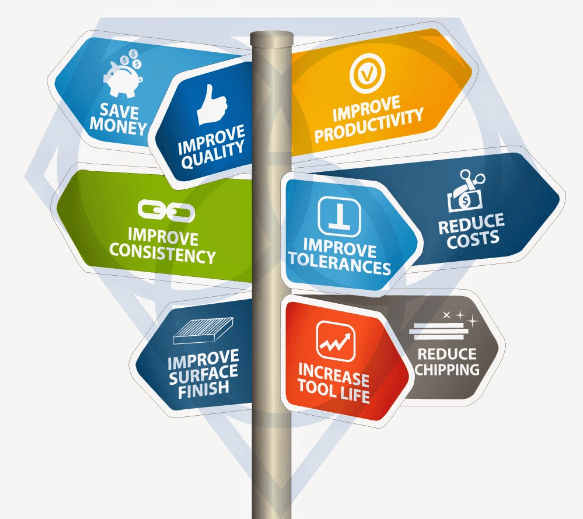



Signup for email offers, updates, and more

UKAM Industrial Superhard Tools is a U.S. High Technology, Specialty Diamond Tool & Equipment manufacturer. We specialize in producing ultra thin & high precision cutting blades and precision cutting machines diamond drills, diamond micro tools, standard & custom advanced industrial diamond tools and consumables.
Shipping Methods

Safe & Secure Payments

© Copyright 1990-2024. UKAM Industrial Superhard Tools – Terms of Use

UKAM Industrial Superhard Tools is a U.S. High Technology, Specialty Diamond Tool & Equipment manufacturer. We specialize in producing ultra thin & high precision cutting blades and precision cutting machines diamond drills, diamond micro tools, standard & custom advanced industrial diamond tools and consumables.
Shipping Methods

Safe & Secure Payments

© Copyright 1990-2024. UKAM Industrial Superhard Tools – Terms of Use
No products in the Quote Basket.
No account yet?
Create an AccountSign up to receive exclusive usage recommendations, Illustrated Trouble Shooting Guides & Sales